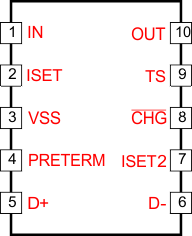SLUS940D September 2009 – May 2021 BQ24050 , BQ24052
PRODUCTION DATA
- 1 Features
- 2 Applications
- 3 Description
- 4 Revision History
- 5 Pin Configuration and Functions
- 6 Specifications
-
7 Detailed Description
- 7.1 Overview
- 7.2 Functional Block Diagram
- 7.3
Feature Description
- 7.3.1 Power Down, or Undervoltage Lockout (UVLO)
- 7.3.2 Power Up
- 7.3.3 D+, D– Detection
- 7.3.4 New Charge Cycle
- 7.3.5 Overvoltage Protection (OVP) – Continuously Monitored
- 7.3.6 CHG Pin Indication
- 7.3.7 CHG LED Pullup Source
- 7.3.8 Input DPM Mode (VIN-DPM or IN-DPM)
- 7.3.9 OUT
- 7.3.10 ISET
- 7.3.11 TS
- 7.3.12 Termination and Timer Disable Mode (TTDM) -TS Pin High
- 7.3.13 Timers
- 7.3.14 Termination
- 7.3.15 Battery Detect Routine
- 7.3.16 Refresh Threshold
- 7.3.17 Starting a Charge on a Full Battery
- 7.4 Device Functional Modes
- 7.5 Programming
- 8 Application and Implementation
- 9 Power Supply Recommendations
- 10Layout
- 11Device and Documentation Support
Package Options
Mechanical Data (Package|Pins)
- DSQ|10
Thermal pad, mechanical data (Package|Pins)
Orderable Information
5 Pin Configuration and Functions
 Figure 5-1 DSQ Package10-Pin WSON With Exposed Thermal PadBQ24050/BQ24052 Top View
Figure 5-1 DSQ Package10-Pin WSON With Exposed Thermal PadBQ24050/BQ24052 Top ViewTable 5-1 Pin Functions
| PIN | I/O | DESCRIPTION | |
|---|---|---|---|
| NAME | NO. | ||
| CHG | 8 | O | Low (FET on) indicates charging and Open Drain (FET off) indicates no Charging or Charge complete. |
| D+ | 5 | I | USB port D+ input connection |
| D– | 6 | I | USB port D– input connection |
| IN | 1 | I | Input power, connected to external DC supply (AC adapter or USB port). Expected range of bypass capacitors 1 μF to 10 μF, connect from IN to VSS. |
| ISET | 2 | I | Programs the Fast-charge current setting. External resistor from ISET to VSS defines fast charge current value. Range is 52.3k (10 mA) to 540 Ω (1 A). |
| ISET2 | 7 | I | Programming the Input/Output Current Limit for the USB or Adaptor source: High = 500 mA max, Low = ISET, FLOAT = 100 mA max. D+D– Detection initially sets the charge threshold and requires ISET2 to change states to take control. |
| OUT | 10 | O | Battery Connection. System Load may be connected. Average load should not be excessive, allowing battery to charge within the 10-hour safety timer window. Expected range of bypass capacitors 1 μF to 10 μF. |
| PRE-TERM | 4 | I | Programs the Current Termination Threshold (5 to 50% of Iout which is set by ISET) and Sets the Precharge Current to twice the Termination Current Level. |
| Expected range of programming resistor is 1k to 10 kΩ (2k: IOUT/10 for term; IOUT/5 for precharge) | |||
| TS | 9 (1) | I | Temperature sense pin connected to ‘50 — 10k at 25°C NTC thermistor, ’52 — 100k NTC at 25°C, in the battery pack. Floating TS Pin or pulling High puts part in TTDM and disable TS monitoring, Timers and Termination. Pulling pin Low disables the IC (CE function). If NTC sensing is not needed, connect this pin to VSS through an external ‘50 — 10-kΩ /’52—100-kΩ resistor. A ‘50 — 250-kΩ/’52 880-kΩ from TS to ground will prevent IC entering TTDM when battery with thermistor is removed. |
| VSS | 3 | – | Ground terminal |
| Thermal Pad | Pad 2x2mm2 | – | There is an internal electrical connection between the exposed thermal pad and the VSS pin of the device. The thermal pad must be connected to the same potential as the VSS pin on the printed circuit board. Do not use the thermal pad as the primary ground input for the device. VSS pin must be connected to ground at all times. |
(1) Spins have different pin definitions